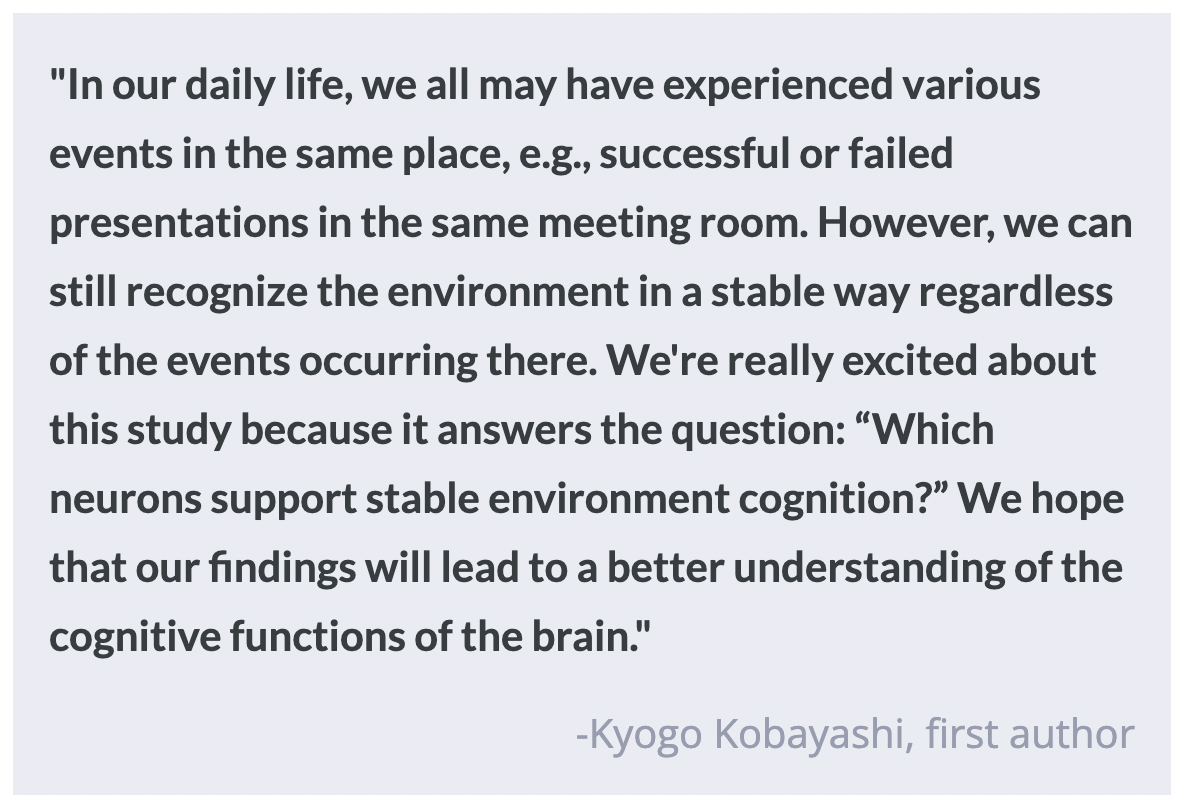How Does the Hippocampus Ensure Consistent Memory of Distinct Environments?
Post by Elisa Guma
The takeaway
A subset of “environment cells” in the hippocampus create an internal representation of specific environments — regardless of salient events that may happen — allowing us to maintain stable memory of distinct environments.
What's the science?
The hippocampus plays a central role in shaping our perception of our environment, allowing us to recognize our surroundings and navigate through them. Within the hippocampus, a subset of cells called “place cells” are responsible for coding information regarding physical location in space, which allows for the creation of an internal representation of a specific environment. However, it is unclear whether the neuronal representation of these environments remains stable after salient (i.e., noticeable or important) events that lead to the creation of distinct new memories occur within them. This week in Cell Reports Kobayashi and Matsuo examine whether the neuronal representation of an environment changes due to subjugation to emotional, hippocampus-dependent experiences (contextual fear conditioning and extinction training) by imaging activity of hippocampal neurons.
How did they do it?
To be able to measure neuronal activity in freely moving animals, the authors used calcium imaging techniques; they injected a viral vector into the dorsal hippocampus (CA1 region) of mice; this vector will transfect neurons with a protein that will fluoresce green when a neuron is active. To record fluorescent activity, the authors implanted a small lens with a mini microscope over the dorsal hippocampus. After recovering from surgery, the mice completed the following behavioral paradigm while neuronal activity was recorded:
Day 1: mice freely explored (5 minutes) a novel experimental chamber (environment B) so authors could analyze the neuronal representation of one novel environment
Day 2: mice were placed in a different novel conditioning chamber (environment A) and allowed to freely explore (5 minutes) before returning to their home cage. Following this initial exploration, mice were placed back in this same chamber (environment A) and given 3 foot shocks (fear conditioning). After fear conditioning, the mice underwent two 30-minute extinction training sessions (with a 5-minute break in-between) wherein they were placed back in the same environment (environment A) without shock to attenuate the fear memory.
Following a 30-minute break, the mice were placed back in this environment two different times to assess contextual fear memory and memory attenuation.
Day 3: mice were exposed again to both environments, A, and B, to test for memory extinction and then placed in environment B again for 4 minutes.
The authors compared neural activity in each of the behavioral sessions across days to determine when activity was highest. The authors employed a data dimensionality reduction technique (i.e., trained a t-distributed stochastic neighbor embedding (t-SNE)) on the neural activity which places each data point in a two- or three-dimensional map, giving the authors a better idea of how similar or different neural activity was across the behavioral paradigms.
Next, the authors tried to find cells, dubbed “environmental cells”, that stably encoded a particular environment. They screened the neural activity from each cell to determine whether certain cells exhibited higher rates of activity in a specific environment. To assess the specificity of these “environmental cells’” activity, they used environmental cell activity to train a decoder to predict whether the neuronal activity of a cell was responding to environment A or B.
What did they find?
First, the authors observed that neuronal activity of the hippocampus was elevated when mice were first exposed to novel environments A and B (compared to baseline activity in their home cage), indicating that this region is responsive to exposure to novel environments. Hippocampal activity was further elevated during both the fear conditioning (foot shock exposure) and fear memory retrieval (when mice were placed back in the conditioning chamber in environment A). Increases were specifically observed in the non-freezing compared to freezing periods of the mice’s activity which may reflect fear memory retrieval processing. Further, the authors confirmed that these increases in hippocampal activity were not correlated with the mice’s motor activity, but rather with the aversive stimulus of the foot shocks.
Decomposition of the neural activity using the t-SNE identified several patterns of activity. Neural activity was more similar within the same environment than across different environments. Further, fear conditioning reduced the similarity of neural activity within environment A, while extinction training increased similarity (compared to pre-fear conditioning activity).
The authors identified “environment cells”: one subset (1.8%) which seemed to be consistently more active in environment A than in other environments, and another subset (4.7%) which were consistently more active in environment B. Next, the authors found that these environment cells were not specialized to encode a specific location within the environment, as only a minority of these cells were identified as place cells (15-25%). Finally, the decoder they trained was able to predict which of the two environments the cells were coding for.
What's the impact?
This study identifies that fear conditioning and extinction training dramatically alter hippocampal activity in the environment where those exposures occurred. Additionally, they identify a subset of hippocampal cells that respond exclusively to the environment, and that these cells decode different environments with high accuracy. These findings provide important insights into the neuronal basis of spatial memory and the neuronal basis for how environments are coded.



